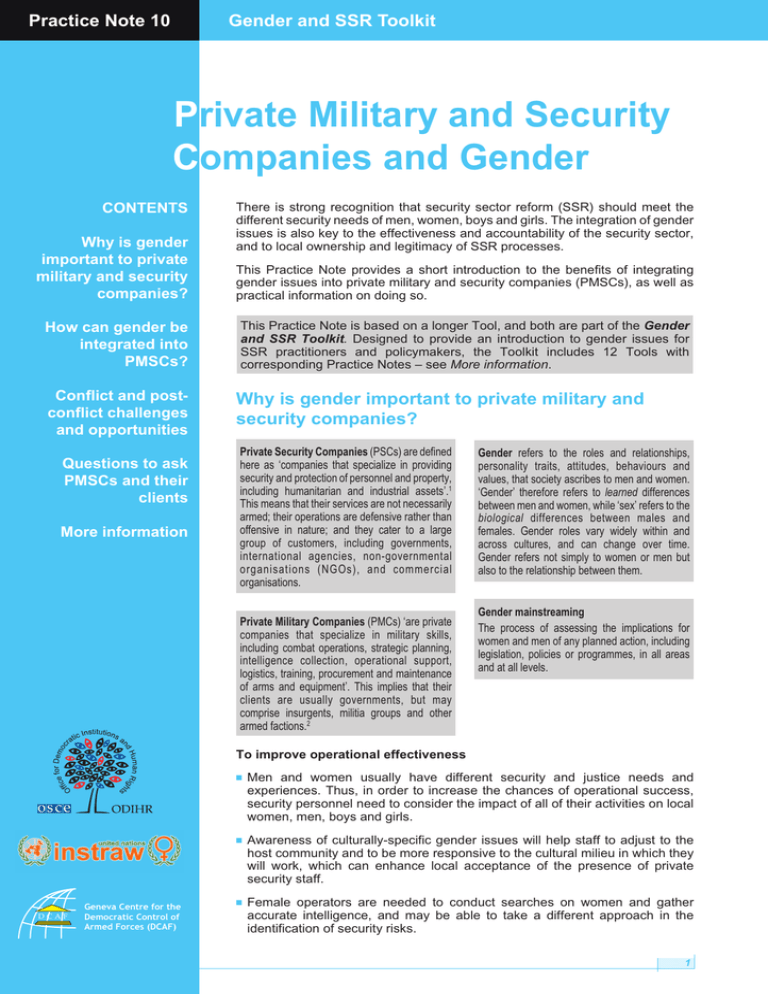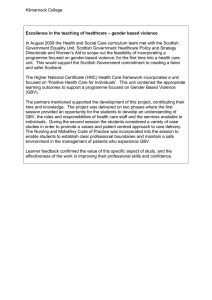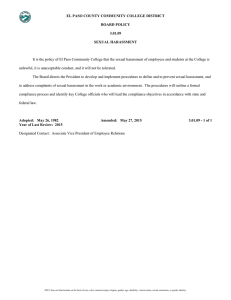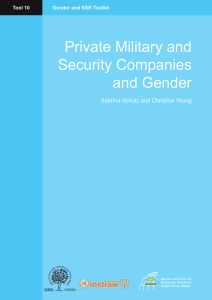P C rivate Military and Security ompanies and Gender
advertisement

Practice Note 10 Gender and SSR Toolkit Private Military and Security Companies and Gender CONTENTS Why is gender important to private military and security companies? How can gender be integrated into PMSCs? Conflict and postconflict challenges and opportunities Questions to ask PMSCs and their clients More information There is strong recognition that security sector reform (SSR) should meet the different security needs of men, women, boys and girls. The integration of gender issues is also key to the effectiveness and accountability of the security sector, and to local ownership and legitimacy of SSR processes. This Practice Note provides a short introduction to the benefits of integrating gender issues into private military and security companies (PMSCs), as well as practical information on doing so. This Practice Note is based on a longer Tool, and both are part of the Gender and SSR Toolkit. Designed to provide an introduction to gender issues for SSR practitioners and policymakers, the Toolkit includes 12 Tools with corresponding Practice Notes – see More information. Why is gender important to private military and security companies? Private Security Companies (PSCs) are defined here as ‘companies that specialize in providing security and protection of personnel and property, including humanitarian and industrial assets’.1 This means that their services are not necessarily armed; their operations are defensive rather than offensive in nature; and they cater to a large group of customers, including governments, international agencies, non-governmental organisations (NGOs), and commercial organisations. Private Military Companies (PMCs) ‘are private companies that specialize in military skills, including combat operations, strategic planning, intelligence collection, operational support, logistics, training, procurement and maintenance of arms and equipment’. This implies that their clients are usually governments, but may comprise insurgents, militia groups and other armed factions.2 Gender refers to the roles and relationships, personality traits, attitudes, behaviours and values, that society ascribes to men and women. ‘Gender’ therefore refers to learned differences between men and women, while ‘sex’ refers to the biological differences between males and females. Gender roles vary widely within and across cultures, and can change over time. Gender refers not simply to women or men but also to the relationship between them. Gender mainstreaming The process of assessing the implications for women and men of any planned action, including legislation, policies or programmes, in all areas and at all levels. To improve operational effectiveness ■ ■ DCAF Geneva Centre for the Democratic Control of Armed Forces (DCAF) ■ Men and women usually have different security and justice needs and experiences. Thus, in order to increase the chances of operational success, security personnel need to consider the impact of all of their activities on local women, men, boys and girls. Awareness of culturally-specific gender issues will help staff to adjust to the host community and to be more responsive to the cultural milieu in which they will work, which can enhance local acceptance of the presence of private security staff. Female operators are needed to conduct searches on women and gather accurate intelligence, and may be able to take a different approach in the identification of security risks. 1 Box 1 PMSCs and self-regulation Self-regulation through industry associations is especially important where government regulation is either inexistent or insufficient. Self-regulation is a critical mechanism to improve standards for PMSCs: - Standards work in two ways. Firstly, they improve the performance, transparency, and accountability of PMSCs. Secondly, they drive ‘cowboys’ out of the industry. However, self-regulation is no silver bullet and is most effective in a context of interlocking and mutually reinforcing regulatory schemes at the industry, national and international levels. - Compliance with standards in hostile environments may be monitored by an industry association. - A self-regulatory body could discuss advantages and problems of gender mainstreaming on a bilateral basis with individual companies if necessary. ■ There is evidence that local men and women tend to see female staff as more approachable and less threatening, even in traditional societies. Thus, the presence of female staff can strengthen the legitimacy of a company and its operations amongst host communities.3 Female staff may also serve as positive role models for local women who are considering joining security sector institutions. To improve staffing procedures and employment standards ■ Men are highly over-represented in PMSCs not least because the companies largely recruit former service personnel. Gender mainstreaming can improve staffing procedures and employment standards within PMSCs to ensure a nondiscriminatory and inclusive work culture. To prevent misconduct and human rights violations ■ Condoning and cultivating certain forms of aggressive behaviour is part of the institutional culture in many PMSCs and has, in the past, been linked to human rights abuses. Appropriate gender training for PMSC operators, alongside training in international humanitarian law (IHL) and human rights law, will help to prevent human rights abuses and the concomitant loss of revenue and reputation. ■ Addressing a perceived culture of impunity will benefit the reputation of individual companies and the industry as a whole. To improve coordination among agencies in peace support operations ■ Many clients of PMSCs, like the United Nations and donor governments, have already mainstreamed gender concerns into their peace support operations and post-conflict reconstruction projects, including SSR. Inclusion of gender considerations by PMSCs would improve coordination regarding the gender policies of all actors operating in complex multiagency environments. Compliance with obligations under international laws and instruments Taking the initiative to integrate gender into PMSCs is not only a matter of operational effectiveness; it is necessary to comply with international and regional laws, instruments and norms concerning security and gender. Key instruments include: ■ The Beijing Declaration and Platform for Action (1995) ■ United Nations Security Council Resolution 1325 on Women, Peace and Security (2000) For more information, please see the Toolkit’s Annex on International and Regional Laws and Instruments. How can gender be integrated into PMSCs? Establish gender-responsive standards and procedures In order to improve standards for PMSCs, a combined approach of contractual obligations on the one hand and regulatory processes on the other is necessary. Clients play a key role in shaping the behaviour of PMSC personnel, especially if contractual obligations are backed up through regular evaluation. ■ ■ ■ ■ ■ 2 Integrate gender issues into the emerging selfregulatory frameworks that govern increasing parts of the industry (see Box 1). The setting and monitoring of standards in the area of gender could be carried out alongside other issues such as human rights. Include compliance mechanisms and internal reporting procedures on sexual harassment, bullying and GBV in company and industrial codes of conduct. Introduce mechanisms for the local community and/or other personnel to report incidents of GBV, discriminatory behaviour or misconduct to an independent authority empowered to investigate. Establish and implement transparent policies and procedures that govern investigations of misconduct, impropriety and criminal activity in order to eliminate impunity. Conduct background checks on all potential PMSC personnel, in particular for prior criminal charges, human rights abuses and GBV. Implement inclusive and non-discriminatory human resources policies and practices Review and, where necessary, reform recruitment processes and human resources policies to ensure a non-discriminatory and inclusive work culture, in particular by addressing issues such as the recruitment, retention and promotion of women; sexual harassment; and discriminatory behaviour. ! Draw upon the wealth of experience in the police, military and the private sector in promoting the recruitment, retention and advancement of women. Conduct gender training Integrate gender issues and gender-awareness training into the basic training given to PMSC personnel (see Box 2): ■ ■ ■ Tailor training to the specific local situation, in order to optimise the effectiveness of the operation. conflict and post-conflict contexts, in particular in Afghanistan and Iraq. Challenges for the integration of gender issues ■ ■ ■ Involve civil society organisations, including women’s groups, in the design and delivery of gender training. Include in the gender training: - How to respond to the distinct needs of both female and male clients. - How to interact appropriately and effectively with victims of GBV. - Internal human resources policies, in particular norms on sexual harassment. Monitor and evaluate ■ Governments should develop national and international monitoring and reporting mechanisms to oversee the PMSC industry that include a focus on human rights violations, including GBV. Clients of PMSCs can monitor the fulfilment of contractual obligations through regular audits and other quality control procedures. It is therefore crucial for clients to include standards of good practice on gender issues in their contracts with PMSCs. Also available in Tool 10… - Discussion of the roles and services provided by PMSCs - Checklist for sexual harassment policies - Model strategy for increasing female recruitment and retention - Gender issues in international and national regulation of PMSCs Conflict and post-conflict challenges and opportunities In conflict and post-conflict countries there is usually a breakdown or shortage of public security services, and PMSCs frequently fill the gap. The dynamics of these countries are of particular interest because of the recent boom in the private security sector in Men, women, girls and boys face different security risks in conflict and post-conflict contexts. PMSC personnel are expected to guarantee their protection, respond to their special security needs and consider their human rights, even though they might not have been given adequate training or background knowledge to do so. International PMSCs operating in (post-)conflict environments, as well as local PSCs in developing countries, tend to recruit some of their most vulnerable and lowest paid employees from marginalised groups in the developing world. These employees are often poor, uneducated, rural men, many of them former soldiers, who have been improperly demobilised and reintegrated into their societies. Enormous challenges follow from these practices and must be addressed by donors, governments and companies alike. Opportunities for the integration of gender issues ■ ■ Monitoring mechanisms for security institutions, in particular PMSCs, are usually absent, which contributes to a general culture of impunity for GBV and other crimes. ■ International PMSCs have started to work in new areas, such as SSR; disarmament, demobilisation and reintegration; and development and disaster relief. The demand for PMSCs in these areas will likely increase, which provides an important opportunity for the development of guidelines on the gender dimensions of these tasks. Post-conflict situations also provide unparalleled opportunities for societal change; where gender discrimination can be redressed and gender roles Box 2 Gender training topics for PMSC personnel - What does ‘gender‘ mean? - Definitions of the core work of PMSCs and understanding the impact on women and on men - Why incorporating gender can increase chances of operational success and effectiveness - Viewing your work through gender spectacles – how to include a gender perspective within your security operational work - Addressing gender in SSR (e.g. working with local women’s organisations, recruitment of women into security forces) - How to work with and protect female and male members of your host community - What does GBV mean? How can it be addressed? - Company codes of conduct and zero tolerance policies on sexual harassment, sexual misconduct and sexually offensive behaviour 3 ■ PMSCs respond to clients’ demands. Hence, there is a real opportunity to create standards and regulations that make PMSCs partners in overall operations. Governments and other clients that contract PMSCs should include accountability for integrating gender issues in PMSC contracts. ? ■ ■ ■ ■ Questions to ask PMSCs and their clients Do governments and other clients demand the inclusion of gender issues (such as accountability for GBV or mandatory gender training) in contracts with PMSCs? Do PMSCs include these issues of their own accord? ■ ■ Have gender issues been included in national and international regulatory frameworks for PMSCs? Do PMSCs have equal opportunity employment practices and codes of conduct that include grievance procedures for complaints about sexual harassment, GBV and discrimination? Are mechanisms in place for the local community to report human rights violations by PMSCs, including incidents of GBV? More information Resources OECD-DAC – OECD DAC Handbook on Security System Reform: Supporting Security and Justice, 2007. ■ ■ ICRC – www.icrc.org International Peace Operations Association – ipoaonline.org/php OECD – www.oecd.org Caparini, M. and Schreier, F., Privatising Security: Law, Practice and Governance of Private Military and Security Companies, Occasional Paper (Geneva: DCAF), 2005. p. 2. 1 4 Do PMSCs include thorough background checks that vet for criminal charges, human rights abuses and GBV in their recruitment processes? Swisspeace – www.swisspeace.org Gender and SSR Toolkit 1. Security Sector Reform and Gender 2. Police Reform and Gender 3. Defence Reform and Gender 4. Justice Reform and Gender 5. Penal Reform and Gender 6. Border Management and Gender 7. Parliamentary Oversight of the Security Sector and Gender 8. National Security Policy-Making and Gender 9. Civil Society Oversight of the Security Sector and Gender 10. Private Military and Security Companies and Gender 11. SSR Assessment, Monitoring and Evaluation and Gender 12. Gender Training for Security Sector Personnel Annex on International and Regional Laws and Instruments Saferworld and Centre for Security Studies – The Sarajevo Client Guidelines for the Procurement of Private Security Companies, 2006. British Association of Private Security Companies – www.bapsc.org.uk Have personnel been trained in identifying and addressing the specific security and justice needs of local men, women, girls and boys? Privatemilitary – www.privatemilitary.org/home.html Abrahamsen, R., & Williams, M., – The Globalisation of Private Security. Country Report: Sierra Leone, 2005. Organisations Have gender issues been integrated into existing training for PMSC personnel? Have they been given specific training on gender-awareness, sexual harassment and sexual exploitation and abuse? Private Security Company Association of Iraq – www.pscai.org Caparini, M., – ‘Applying a Security Governance Perspective to the Privatisation of Security’, Private Actors and Security Governance, 2006. Swisspeace – The Impact of Private Military and Security Companies on the Local Population in Post-Conflict Countries: A Comparative Study for Afghanistan and Angola (Forthcoming). Have mechanisms been established to increase the recruitment, retention and advancement of female personnel? Each of these Tools and Practice Notes are available from: www.dcaf.ch, www.un-instraw.org and www.osce.org/odihr. This Practice Note was prepared by Nadia Nieri of UNINSTRAW based upon Tool 10, in consultation with Sabrina Schulz and Christina Yeung. Ibid. Valenius,J., Gender Mainstreaming in ESDP Missions (Institute for Security Studies. Paris), 2007, p. 28. 2 3 © DCAF, OSCE/ODIHR, UN-INSTRAW, Gender and Security Sector Reform Toolkit. Eds. Megan Bastick and Kristin Valasek. Geneva, 2008. re-defined. PMSCs can participate in these processes by setting positive examples through the recruitment and equitable treatment of women.





